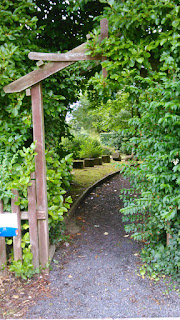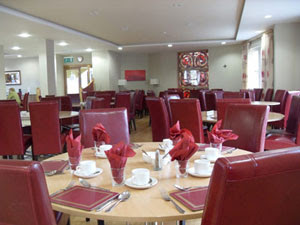Larne - Drumalis
My blog entry is a little out of sink in terms of time log.
However, I seem to just grab moments to write when come. ;o)
WELCOME TO DRUMALIS
After much needed sleep we left Dublin heading towards Northern Ireland to a small place called Larne. It is here that our congregation has a retreat house in which our meeting was to take place. Not just any retreat house I must admit, one that is itched of history and life. It is located on a hill next to the sea holding views one so often sees on the screen of The Irish Channel, Islandmagee, Larne Lough, MaghermonUrNe, The Scottish Coast, the high lands of Kilwaughter. Coming out of the main entrance you enter onto the scenic Antrim Coast with its Nine Glens. Its location is set off from the street leaving a sense of been in the middle of the countryside. The grounds are very spacious, offering many long walks.
Today the main building is a heritage house, with many visitors coming to learn of its history - including family members of previous owners.
One lunch time we were offered a tour by Sister Anna filling us in on all the details, how the features came to life and brought about a connection to those who had walked on the floor boards before us.
The First building was a monastery in the Middle Ages where the monks of the Premonstratensian order offered rest and refuge to the sick and travellers and the beautiful house that still stands today, built in the 19th Century as the family home of the great Presbyterian industrialist and philanthropist, Sir Hugh Smiley.
The house is a standing complete museum of George Walton work. Walton (1867-1833) was a Glasgow contemporary of the now hugely popular Charles Rennie Mackintosh and he produced the detail of the house - it is said that no two doorhandles in Drumalis are exactly the same. There was never stencils so even though things appear to be patterned on closer inspection there is difference present.
 |
| These are the original windows, that are taken from the old chapel building and put throughout the buildings. |
The stain glass windows are amazing example of his work, with its gorgeous red and green, inscribes the linkage of Scotland and Ireland in the Kerr/Smiley marriage in lines of poetry written in the windows and images of the red hand of Ulster and the thistles of Scotland. There is scholarly interest in the house as the most complete “company job” undertaken in Walton’s early period and because the little wooden fitted cabinet in one of the front sitting rooms of Drumalis, with its secret drawers, is the only surviving piece of furniture attributable to Walton from before 1896 which can be confidently dated.
 |
| Peace Garden |
Anna told the story of how the family children were never allow to come into the dinning room due to the strictures of the social divisions of the time, especially after Hugh Smiley was elevated to the peerage in 1903 as a baronet. A granddaughter of the house remembers her mother telling her how children were not given access to the dining room, on one special occasion when there was visitors with children allowing her to eat in the dinning room and broke the rules of etiquette. A footman, familiar to the children from the other parts of the house asked if she would like more vegetables and she replied “thank you dear James” throwing her hands up to emphasis her delight. For this she was reprimanded soundly for being over familiar with a serving man. James would have been one of a veritable army of staff who ran the house inside and our and maintained its magnificent grounds.
The house is open for tours, and one question that often comes up is how a group of nuns have obtain the house. Please note we are in the Northern Ireland…
 |
| Flowers in the garden |
Once Sir Hugh Smiley past away, Lady Smiley stayed on in the house. In the mid 1920s it became clear to Lady Smiliey that she would have to sell Drumalis. None of her children had decided to make their lives in Larne but were settled in Scotland and England. The Catholic religious order which was to occupy the house eventually - us - did not do so immediately. In the Larne of the time, the sale of one of the local ‘big houses’ to an order of Catholic nuns would have been unthinkable and so it was a more protracted process.
First the house was sold in 1927 to a local developer Mr Wililam Crawford, who had started Ireland’s first ever Electric Light Company. There was talk that he would build houses on the land but the house was sold again in 1929 to a Mrs Magill, the wife of a local JP. It is told that the sisters asked Mrs Magill who was catholic yet married to a presbyterian, to purchase the house with their funds. She stayed in the house for a year when she hand over the land to the nuns of the Cross and Passion order - its present owners.
SO this is Drumalis, there is so much more to write about however I will simply place the website if you wish to seek more. I have taken some of the information from the website ;o) If your ever in Ireland I would highly recommend coming to stay here, the atmosphere is full of peace, joy and a celtic charm. This is not only credit to those who have gone before us, adding their charm and character to the building, yet those who work there. The team is all heart workers, they give their all, embracing hospitality to a new level where service is so high. They have achieved five star restaurant. Truely an amazing place because of the people, team who work behind the scenes in all departments.
All that is left is to give you some photos…. after six days it is with a sense of peace we move onto our next adventure…
 |
| Entrance stairway/ gathering space |
 |
| Dinning Room |
 |
| New part - retreat house rooms. |
 |
| View out to sea from tower |
 |
| Rose Garden, looking down into it. |
 |
| Looking down from tower |








Comments
Post a Comment